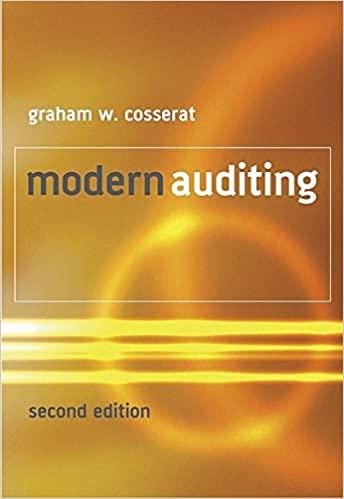Question
On December 1, 2020, Cambridge Printers had the account balances shown below. Debit Credit Cash 14,650 Accumulated DepreciationEquipment 1,500 Accounts Receivable 3,900 Accounts Payable 3,000
On December 1, 2020, Cambridge Printers had the account balances shown below.
| Debit | Credit | ||
| Cash | 14,650 | Accumulated DepreciationEquipment | 1,500 |
| Accounts Receivable | 3,900 | Accounts Payable | 3,000 |
| Inventory | 1,950* | Share CapitalOrdinary | 20,000 |
| Equipment | 21,000 | Retained Earnings | 7,000 |
|
|
| Loan Payable | 10,000 |
| 41,500 | 41,500 |
*(3,000 0.65)
The following transactions occurred during December.
| Dec. 3 | Purchased 4,000 units of inventory on account at a cost of 0.72 per unit. |
| 5 | Sold 4,400 units of inventory on account for 0.92 per unit. (It sold 3,000 of the 0.65 units and 1,400 of the 0.72.) |
| 7 | Granted the December 5 customer 184 credit for 200 units of inventory returned costing 144. These units were returned to inventory. |
| 17 | Purchased 2,200 units of inventory for cash at 0.78 each. |
| 22 | Sold 2,000 units of inventory on account for 0.95 per unit. (It sold 2,000 of the 0.72 units.) |
Adjustment data:
- 1. Accrued salaries payable 400.
- 2. Depreciation 200 per month.
- 3. Loan Payable has an annual interest rate of 12%;
- 4. Income Taxes are estimated at 30% of pre-tax profit.
- 5. The following additional accounts are available: Interest Expense; Interest Payable; Income Tax Expense; and Income Tax Payable.
Instructions
a. Journalize the December transactions and adjusting entries, assuming Cambridge uses the perpetual inventory method.
b. Enter the December 1 balances in the ledger Taccounts and post the December transactions. In addition to the accounts mentioned above, use the following additional accounts: Cost of Goods Sold, Depreciation Expense, Salaries and Wages Expense, Salaries and Wages Payable, Sales Revenue, and Sales Returns and Allowances. (The T accounts are needed just to calculate the ending account balances. The form does not matter. Also, you need not X ref either in the T accounts or in the journal.)
c. Prepare an adjusted trial balance as of December 31, 2020.
d. Prepare a SOCI and Balance Sheet
e. Compute ending inventory and cost of goods sold under FIFO, assuming Cambridge uses the periodic inventory system.
f. Compute ending inventory and cost of goods sold under averagecost, assuming Cambridge uses the periodic inventory system.
g. Assume the balance for Inventory on January 1, 2020, was 1,200. Also, assume that all sales during the year were on credit, terms n/30, as per industry standard, and that the average monthly sales for 2020 were approximately the same as for December 2020. Calculate the approximate inventory turnover and days in inventory for 2020 using the SOCI from part d., and draw a conclusion whether this is favourable or not. Explain your answer.
Step by Step Solution
There are 3 Steps involved in it
Step: 1

Get Instant Access to Expert-Tailored Solutions
See step-by-step solutions with expert insights and AI powered tools for academic success
Step: 2

Step: 3

Ace Your Homework with AI
Get the answers you need in no time with our AI-driven, step-by-step assistance
Get Started


